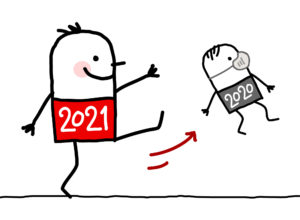
Whether it is at a big project milestone, or end of the quarter or year, taking the time to acknowledge and recognize your wins and learn the lessons from experience will help you build on your successes and continue to innovate. Read on for some of my favorite Retrospective questions and best practices for success in the coming year!
1: Celebrate your wins, large and small.
Research and your own experience show how important it is to pause and acknowledge your progress. Such reflection improves employee engagement and retention, the ability and motivation to persevere, and the likelihood of long-term success.
Here are just a few of the successes our clients are celebrating this year, some of which can be overlooked if we focus exclusively on financial metrics:
- Individual and team growth, competence, capacity and confidence development
- Expansion and diversification of your Relational Web of skills, knowledge, talent and resources that enable you to be agile and innovate through the unexpected and unplanned
• Business results in key strategic areas:
- Time to Market
- Customer acquisition, satisfaction, and retention
- The triple bottom line

2: Host a Retrospective.
In addition to celebrating your wins, consider hosting a year- or quarter-end Retrospective. As you may know, most agile methodologies include periodic retrospectives, in which the agile team reflects not just on WHAT it accomplished, but HOW it accomplished it and what lessons they learned that can guide them going forward.
Here are a few of my favorite retrospective questions to help you amplify your strengths and build on your areas of opportunity in the coming year:
- When were you at your best?
- How did you learn and adapt as you worked together?
- Which of the Agility Shift dynamics did you actively demonstrate? Which do you need to develop and more consistently demonstrate? (Take the complimentary Agility Shift Inventory (ASI) to start this conversation, or contact us for a comprehensive Team ASI)
- What lessons did you learn that could guide your success with your team?
- Bonus Question inspired by Jeff Sutherland’s work: What one thing could you have done differently that would have made you happier?
3: Be More Agile in 2021.

Once you have celebrated and completed your reflections you will have a valuable list of successes to recognize and share across your organization. You will also have identified some exciting areas for new learning and talent development.
The next three questions can help you zero in on your areas of greatest opportunity by thinking about WHAT you want to get done, WHO would benefit most and HOW to realize those benefits:
- Which of your key stakeholders and leaders have the necessary agility competence, capacity and confidence to execute your agile innovation initiatives and which could benefit from additional support?
- How will your talent development strategy help your people at all levels develop their agility ability?
- Who will champion these critical capabilities across the organization to help you achieve and sustain your commitment to agility?
You are not alone if you struggle to answer some of these questions. We regularly work with leaders and teams to help them discover the best agile learning and talent development strategies to meet their business goals.


 is a new opportunity to strengthen and engage your Relational Web and you should take it!
is a new opportunity to strengthen and engage your Relational Web and you should take it! building your relationships. Do you have some gaps in your Relational Web that need filling in? Maybe you are looking for an executive coach to recommend to a client or additional marketing resources. Remember,
building your relationships. Do you have some gaps in your Relational Web that need filling in? Maybe you are looking for an executive coach to recommend to a client or additional marketing resources. Remember,  Talking about what you enjoy is often contagious and will open up the conversation. Some of my favorite non-work topics are skiing (though be careful of showing too much interest!), recent travel adventures and the latest developments in arts and culture. Be sure your enthusiasm doesn’t hi-jack the conversation. Share just enough to give others a chance to share theirs.
Talking about what you enjoy is often contagious and will open up the conversation. Some of my favorite non-work topics are skiing (though be careful of showing too much interest!), recent travel adventures and the latest developments in arts and culture. Be sure your enthusiasm doesn’t hi-jack the conversation. Share just enough to give others a chance to share theirs.




